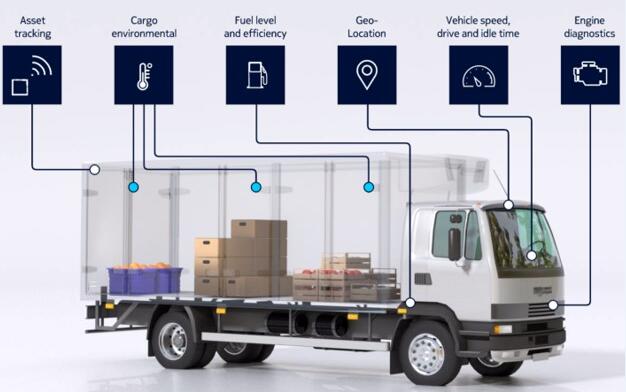
Cold chain logistics GPS technology, GPS real-time, all-weather, continuous, fast and high-precision characteristics can bring a substantial change to the logistics and transportation industry, and will play an increasingly important role in the development of the logistics industry effect.
The cold chain product solution provided by Roadragon can query the location of the vehicle transporting goods at any time, which not only strengthens the monitoring of the vehicle, but also avoids detours, selects the optimal route, reduces vehicle loss and transportation time, reduces transportation costs and achieves obvious economic benefits. benefit. The application of GPS technology in cold chain logistics greatly improves the quality of transportation and effectively guarantees the transportation time, thereby ensuring the quality and timely arrival of cold chain products. Based on the GPS technology applied to the cold chain logistics transportation process control machine, Roadragon gives the structure of the entire logistics information system. The information system organically integrates advanced temperature and humidity information detection and GPS technology, and implements comprehensive monitoring and management of transportation operations, which not only improves the accuracy of information in transportation, but also realizes real-time automation of transportation management.
Judging from the current status of the global refrigeration and refrigeration business industry chain, the collection, analysis, and processing of consumer information at the terminal form the development and guidance of fresh food, and then the distribution and sales of new products to the market. The information in the entire process is poor and the response is slow. The service network and information technology application of cold chain food are not perfect, which greatly affects the in-transit quality, accuracy and timeliness of food logistics, and the cost and commodity loss of cold chain are very high. Therefore, advanced information technology should be used to keep abreast of food production, processing, and storage information; master the quantity, location and temperature of frozen and refrigerated products in the supply chain. Comprehensive and dynamic monitoring of the transportation of refrigerated trucks, thereby improving the operational efficiency and management level of cold chain logistics.
Due to the real-time, all-weather, continuous, fast and high-precision characteristics of GPS, if it is applied to the logistics and transportation industry, it can bring a substantial change to it, which can greatly improve the quality of transportation and effectively guarantee the transportation time. Ensuring the quality and timely arrival of cold chain products will play an increasingly important role in the development of the logistics industry.
Because cold chain products must be stored and transported at low temperature, if accidents such as vehicle breakdown or paralysis of the refrigeration system occur during transportation, the quality of cold chain products will be greatly affected. Therefore, GPS positioning technology is applied to cold chain logistics to realize resources through the network. Sharing, monitoring the running route of the vehicle, the real-time running position of the vehicle and cargo, the safety of the personnel, the running condition of the vehicle and the temperature in the compartment during the cargo transportation process, and the real-time and accurate grasp, which is convenient for the command and dispatch of the vehicle. In emergencies, make decisions quickly.
The application of GPS technology in cold chain logistics and transportation, the application of GPS in cold chain logistics includes:
(1) Vehicle tracking. Real-time tracking and display of selected vehicles can be achieved through GPS technology, and the GIS geographic information system can be used to display the positioning results, which can intuitively reflect vehicle location, road conditions, distance from the nearest cold storage, and distances to vehicle running routes.
(2) Operation monitoring. It can realize multi-window and multi-screen monitoring of multi-vehicle operation at the same time, can accurately report vehicle position (including location, time) and operating status (including engine, temperature, speed), and can analyze vehicle mileage, speeding and other operating information within a specified time. Statistics to understand whether the goods are safe on the way, whether they can arrive quickly and effectively, and provide route analysis, route optimization, and record the historical trajectory of vehicles for operation evaluation and command and dispatch. When a vehicle accident occurs, information such as the location and condition of the accident vehicle can be reported to the monitoring center in a timely and accurate manner, and decisions can be made quickly to minimize accident losses.
(3) Information query. It can intuitively understand the geographic location of the transport vehicle from the GIS geographic system in real time, and can also query the driving route, time, mileage and other information. The system can automatically compare the data sent by the vehicle with the preset data, and report the large deviation. The display screen can immediately display the alarm target, and plan the optimal assistance plan to avoid situations that endanger the safety of people, vehicles and goods. occur.
(4) Command and dispatch. The monitoring center can dynamically dispatch and manage all vehicles in the system based on the running status of vehicles. By implementing vehicle scheduling, the actual load rate of vehicles can be increased, the empty driving rate of vehicles can be effectively reduced, transportation costs can be reduced, and transportation efficiency can be improved.
(5) Route planning. According to the different types of goods, delivery places, and transportation time, GPS technology can be used to design the optimal driving route, including the fastest route, the easiest route, and the route with the least number of highway sections. After the route is planned, the three-dimensional navigation function of GPS is used to display the designed route and the vehicle running route and operation method through the display.
The GPS positioning system solves the outstanding problems caused by poor information communication, such as serious empty driving of vehicles, unsecured cargo transportation, poor reliability of vehicle qualifications, and difficulty in vehicle scheduling. Obtain good economic benefits.
Post time: Feb-10-2022
